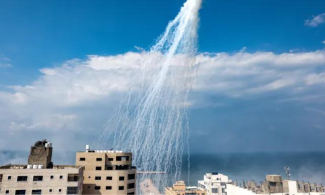
Image Credit: Mohammed Abed/AFP
Human Rights Watch has condemned Israel’s use of white phosphorus in its military operations in Gaza and Lebanon.
The organisation on Thursday said the use of white phosphorus in military operations in Gaza and Lebanon puts civilians at risk of serious and long-term injuries.
Human Rights Watch on its website said it verified videos taken in Lebanon and Gaza on October 10 and 11, 2023, respectively, showing multiple airbursts of artillery-fired white phosphorus over the Gaza City port and two rural locations along the Israel-Lebanon border, and interviewed two people who described an attack in Gaza.
White phosphorus, which can be used either for marking, signaling, and obscuring, or as a weapon to set fires that burn people and objects, has a significant incendiary effect that can severely burn people and set structures, fields, and other civilian objects in the vicinity on fire.
The use of white phosphorus in Gaza, one of the most densely populated areas in the world, magnifies the risk to civilians and violates the international humanitarian law prohibition on putting civilians at unnecessary risk, the human rights organisation said.
“Any time that white phosphorus is used in crowded civilian areas, it poses a high risk of excruciating burns and lifelong suffering,” said Lama Fakih, Middle East and North Africa director at Human Rights Watch. “White phosphorous is unlawfully indiscriminate when airburst in populated urban areas, where it can burn down houses and cause egregious harm to civilians.”
According to the organisation, on October 11, it interviewed by phone two people from the al-Mina area in Gaza City, who described observing strikes consistent with the use of white phosphorus. It said one was in the street at the time, while the other was in a nearby office building.
Both described ongoing airstrikes before seeing explosions in the sky followed by what they described as white lines going earthward, it said.
According to Human Rights Watch, they estimated that the attack took place sometime between 11:30 a.m. and 1 p.m. Both said that the smell was stifling. The person who was in his office said that the smell was so strong that he went toward the window to see what was happening and then filmed the strike.
Human Rights Watch reviewed the video and verified that it was taken in Gaza City’s port and identified that the munitions used in the strike were airburst 155mm white phosphorus artillery projectiles.
Other videos posted to social media and verified by Human Rights Watch show the same location. Dense white smoke and a garlic smell are characteristics of white phosphorus.
Human Rights Watch also said it reviewed two videos from October 10 from two locations near the Israel-Lebanon border, adding that each shows 155mm white phosphorus artillery projectiles being used, apparently as smokescreens, marking, or signaling.
Upon contact, white phosphorus can burn people, thermally and chemically, down to the bone as it is highly soluble in fat and therefore in human flesh. White phosphorus fragments can exacerbate wounds even after treatment and can enter the bloodstream and cause multiple organ failure.
Already dressed wounds can reignite when dressings are removed and the wounds are re-exposed to oxygen. Even relatively minor burns are often fatal.
For survivors, extensive scarring tightens muscle tissue and creates physical disabilities. The trauma of the attack, the painful treatment that follows, and appearance-changing scars lead to psychological harm and social exclusion.
The use of white phosphorus in densely populated areas of Gaza violates the requirement under international humanitarian law to take all feasible precautions to avoid civilian injury and loss of life, Human Rights Watch said.
Israel’s use of white phosphorus comes amid hostilities following Hamas’ deadly attacks on October 7 and subsequent rocket attacks that have killed. As of October 12, more than 1,300 Israelis, including hundreds of civilians, and taking of scores of Israelis as hostages in violation of international humanitarian law.
Heavy Israeli bombardment of Gaza in this period has killed, according to Gaza’s Health Ministry, more than 1,400 Palestinians in Gaza, including scores of civilians, and displaced more than 338,000 people.
Many communities in southern Israel have also been displaced and more than 1,500 Palestinian militants reportedly died in Israel. Israeli authorities have cut electricity, water, fuel and food into Gaza, in violation of the international humanitarian law prohibition against collective punishment, exacerbating the dire humanitarian situation from over 16 years of Israeli closure.